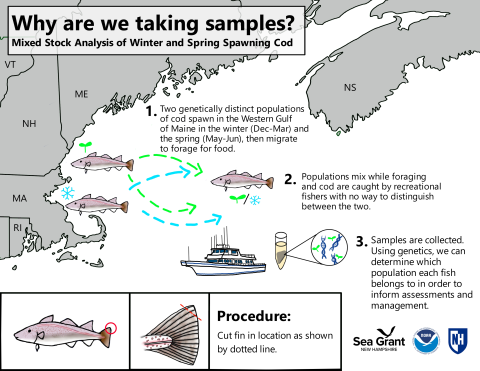
Recent updates to the Atlantic Cod (Gadus morhua) management strategy reflect the complex structure of our local cod populations, breaking the U.S. cod stocks into four management units from the prior two. While this captures new complexity, this plan does not separate the distinct spawning populations in the Western Gulf of Maine, which spawn separately in two different seasons – winter and spring. The spring population has been observed to be in decline, and further management without differentiating these two populations could potentially lead to overharvest or inaccurate assessment of the weaker spring stock. Adrienne Kovach and her research team will partner with recreational fishers to collect cod samples, which are assigned to winter and spring spawning source populations using a genetic stock discrimination tool and a gene expression study. Together, this project will reveal the stock composition of the fishery, help inform future sustainable management of Atlantic Cod, and engage with the regional fishing community throughout the process.
Principle Investigator

Adrienne Kovach, Ph.D.
Department of Natural Resources and the Environment, University of New Hampshire
Adrienne.Kovach@unh.edu
Co-Investigator
Linas Kenter, Ph.D.
NH Sea Grant & UNH School of Marine Science and Ocean Engineering
Linas.Kenter@unh.edu
Project Funding Cycle
2024-2025 NH Sea Grant Biennial Research Funding
Project Abstract
Recent updates in our understanding of Atlantic cod stock structure have led the Atlantic Cod Research Track Stock Assessment Working Group of the Northeast Fishery Science Center to recommend that cod management structures more closely align with the biological populations. Consequently, assessments are newly being conducted at the scale of four distinct units: 1) Georges Bank; 2) southern New England; 3) western Gulf of Maine, and 4) eastern Gulf of Maine, instead of the two management units considered to date. These new units correspond with four of five spatially distinct biological populations identified by the Atlantic Cod Stock Structure Working Group; however, they do not recognize the occurrence of two spatially overlapping, genetically and ecologically distinct populations that spawn separately within western Gulf of Maine in two different seasons –winter and spring. Understanding the contribution of these two stocks to the mixed fishery is necessary to manage them effectively and ensure that neither component is over-fished. To address this goal, we will 1) partner with recreational and commercial fishermen to collect genetic samples; 2) apply a high-resolution genetic stock discrimination tool to determine the composition of the western Gulf of Maine recreational fishery across the breadth of fishing operations – spatially and temporally, and in comparison with the commercial fishery; and 3) conduct a differential gene expression study to reveal physiological mechanisms underlying ecological differences between the winter and spring-spawning cod stocks and the role of environmental conditions, especially temperature, in their differential adaptation. Integrating resulting new knowledge from these objectives will yield insight about the potential causes of decline of the weaker, spring-spawning component. This project will provide critically needed information to fishery managers of the Northeast Fishery Science Center and New England Fishery Management Council for achieving improved spatial management of the Atlantic cod fishery. Outreach efforts implemented in a community science framework will extend the impacts of our work broadly to recreational fishers, young fishers in the New England Young Fishermen’s Alliance, experienced fishers in the Cape Cod Fishermen’s Alliance, and other marine/ocean users.
Related Links
Project Resources

Infographic by Kara Hatalsky (UNH '27)
Project News
Coming soon!